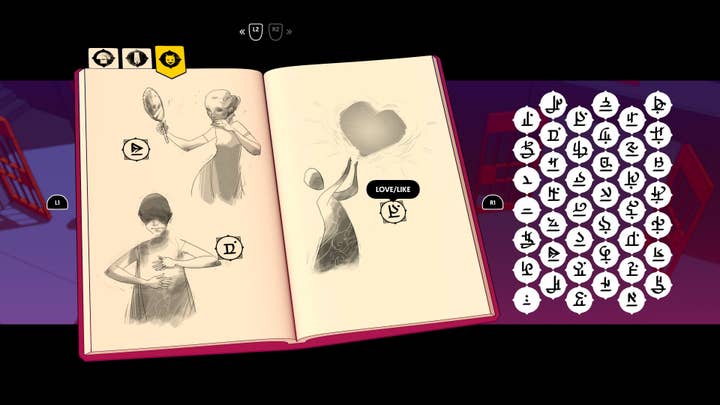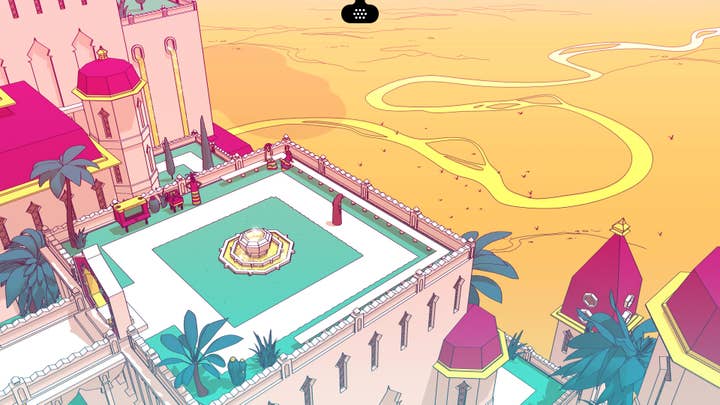Finding power in language with Chants of Sennaar
Julien Moya and Thomas Panuel of Rundisc discuss the importance of finding the right publisher and crafting one of the most reflective puzzle game of our turbulent times
2023 was a year brimming with remarkable indie games that left an indelible mark in many players' lives, not to mention wallets. With the market competition higher than ever, it‘s unclear how many brilliant titles don't even reach the public surface - as is always the case. One that did break through, however, was Chants of Sennaar, a love letter to communication and one of the most original games of last year's harvest.
Developed by Rundisc – an independent studio formed by Julien Moya and Thomas Panuel, two French artists who were introduced by a mutual friend in 2015 and bonded over their love for video games – Chants of Sennaar tasks players with deciphering glyphs that form the languages found in this Tower of Babel-inspired world.
At the beginning, you start simple. For example, matching the symbols to 'open' and 'close' simply by using a lever to move the gates up and down. If matched correctly, the hooded protagonist will note the translation next to beautiful hand drawings in his journal, which players can then use to get a better sense of other hieroglyphs – a no less fulfilling process than climbing an endless mountain in Jusant or, say, learning Mandarin.
The pre-production of Chants of Sennaar began in the spring of 2019, almost half a year since the studio‘s first game Varion came out. Today, however, this earlier title has no more than 14 reviews on Steam - four more than needed for it to be visible in the search queue, and 609 times less than Chants of Sennaar's current review count.
"Even though we're quite proud of our first game, we consider Varion to be 'training'," Panuel told GamesIndustry.biz. "In developing this game, we had no other aim than to have fun and learn."
"The languages in Chants of Sennaar are puzzle elements like any others. They were created as part of a game design process, not a linguistic one"
Julien Moya, Rundisc
Though the approach to their second project was no different, the pair decided the training wheels were off this time. And with that, the ambition to do bigger and better was raised. But how do you let the rest of the world know about your ambitious project when there are thousands of aspiring developers competing for the same slice of the market?
According to the duo, Chants of Sennaar drew inspiration from such beloved indie titles like Lucas Pope's Return of the Obra Dinn, The Talos Principle and Outer Wilds. The primary influence, however, belongs to 2019's Heaven's Vault, which tasks players with its own set of language-deciphering challenges. While Moya didn't enjoy the game as he hoped he would, as a fan of typography and linguistics, he thought the sum of its parts could make a promising basis for their game.
After a year and a half spent putting together the initial demo of Chants of Sennaar during their spare time, – with Moya's wife, Rachelle Bartel, lending a hand with the illustrations found in the player's journal – he and Panuel decided to try their luck pitching it to a publisher.
In 2021, in the midst of the pandemic, the pair arranged a meeting with Focus Interactive during their time at Gamescom, which was 100% virtual second for the second time in a row. The executives at Focus were so impressed with the Chants of Sennaar demo that they offered to financially support the remaining development of the project, becoming the game's publisher and co-producer. Not only did this allow Moya to resign from his daily job and dedicate himself to working on the game full time – something Panuel wish he'd also done, he told Bloomberg – it granted the chance to bring in a freelance sound designer and composer to their humble team.
While it may seem that the easy part was done and the stars were pretty much aligned for Chants of Sennaar's success from there on out, Moya explains that it was in fact the other way around.

"The most difficult part of the development process was getting the core gameplay right. We knew very early on what kind of game we wanted to make and what ideas we wanted to build on, but translating those ideas into functional, fun gameplay was not an easy task," he says.
Indeed, it is easy to see why figuring Chants of Sennaar's core gameplay loop out can be a headache. As a player, all you do is interact with each NPC, each signpost and try to connect the dots yourself. Of course, the linguistic journey is sprinkled with more traditional puzzles and stealth sections that give time for all new information to digest. And while successfully chipping away at once completely foreign language was a thrill familiar to many of us before games like Chants of Sennaar or Heaven's Vault, it was difficult to imagine this being an attractive gameplay mechanic non-linguist players would be excited for.
"A lot of work went into determining the exact design rules and creating the tools available to the player," Panuel adds. "This work took several months, during which every solution we found seemed to create two or three new problems, and we sometimes doubted we'd be able to make it all work."
Fortunately, after months of testing and reflection, the pair struck a gameplay model that was as satisfying as it was engaging. The next challenge, then, was to make it accessible to both inquisitive players and those who are less prone to frustrations that come with learning an entire language, even if fictional.
"A lot of work went into determining the exact design rules and creating the tools available to the player"
Thomas Panuel, Rundisc
"Once we had a first complete version of a level, we played it through a small audience of testers and collected their feedback. On the whole, things worked well, but there were always times when things were perceived as too easy or too difficult," Moya explains, comparing the balancing act to the work of an illusionist.
"We added or reworked gameplay elements, added clues, and made certain puzzles more complex, to adapt the difficulty and learning curve until as many testers as possible were totally satisfied with the experience, with just the right amount of frustration to make solving the puzzles rewarding."
For Rundisc, it was important that the central pillar of Chants of Sennaa – the five ancient languages players will discover as they move along the tower's floors – supported the gameplay and narrative, and not the other way around. This led to the decision to invent the languages themselves without consulting professional linguists or, say, Babelian historians.
"The game's languages are inspired by existing ones only in terms of form," says Moya. "As with the architecture of the sets, we generally proceeded by mixing two or three different sources to create something new.
"For example, for the language of The Devotees, whose culture evokes Mediterranean antiquity, we drew inspiration from Latin and Phoenician alphabets, with a touch of cuneiform. For the Bards, the script was created by mixing Arabic Kuffic and Indian Devanagari."
The tongues of Anchorites, Alchemists and Warriors, he adds, are entirely made up.
"We were looking to create fantasy languages designed for the needs of the game. There was no scientific intent. The languages in Chants of Sennaar are puzzle elements like any others. They were created as part of a game design process, not a linguistic one."

Another principal design decision, one that will be evident for anyone who finished Chants of Sennaar, was made when crafting the closing chapter of the game, Exile. Here, the acquisition of the final language feels different, even voluntary.
"We felt that this special treatment was necessary to avoid the redundancy that would otherwise have begun to appear. As with the overall length of the game [around 8-10 hours], we preferred to keep the experience interesting and fresh right up to the end, rather than stretching the game out to the point of losing intensity," Moya explains.

This approach to design and the ability to circumvent weaknesses, turning them into the game's strongest assets, then, is also noticeable in Chants of Sennaar's visual style. The pair knew from the beginning that they had limited resources at hand.
"We had to develop a style that would overcome our limitations and show what we were capable of doing while avoiding comparisons to others as much as possible," Moya says.
"I would never have had the time to create UV coordinates for all of the game's assets on my own, so we decided to work without textures at all. This decision, and others like it, soon led us to experiment with some very special types of renders, including a 'wireframe' render that allowed the edges of objects to show through."
After a few trial runs, the pair realized that what they achieved was a radically minimalistic look similar to that of Franco-Belgian comic books. As a result, Rundisc agreed to pursue this style further, turning to comics artists like Philippe Druillet, Mœbius and François Schuiten for inspiration, which eventually shaped the game's memorable aesthetic. As for its labyrinthian world, Moya was particularly inspired by Saint-Étienne Cathedral, located in the centre of Toulouse, France, as well as Roman and Moorish architecture, and the works of Thierry Urbain.
"Even when we create a fantasy universe, it's just a reflection of our own history"
Julien Moya, Rundisc
If the architecture and static camera angles of Chants of Sennaar often evoke the magical confusion of M. C. Escher's artwork, that is by design.
"From the very beginning, we wanted to recreate the sense of strangeness that came from the old isometric adventure games of the 1985-1988 period," Moya says. "La Abadía del Crimen, Get Dexter, Knightlore, Fairlight – all of these games managed to create a very special atmosphere with very few resources, developing labyrinthine levels populated by strange characters.
"From the moment the concept of languages came into the design, and then all along the rest of the development, we tried to reproduce the feeling of the traveller – the feeling you might have when you get off a train or a plane and find yourself in a country whose language you know nothing about.
"At first, you don't understand what you're seeing and hearing, you're lost. Then, of course, your brain starts working: you overhear conversations, read billboards, signs or newspapers, see TV shows... you begin to understand certain words, form hypotheses, test them one by one, and after a few days you end up forming whole sentences, becoming less and less alien to your surroundings. This exhilarating feeling of gradually integrating into a culture through its language, of feeling part of the group again, is what we wanted to give the player."
One of the highlights Chants of Sennaar, one that is as striking as its visuals or labyrinthine map, only becomes apparent at the last stages of the game. Here, the player becomes the unofficial translator of the tower, in effect having to use the multilingual powers to connect the clans fragmented by confusion.

The first inspiration for Chants of Sennaar's narrative, Moya says, comes from the Indian fable, 'The Six Blind Men and The Elephant.' As the parable's title suggests, a group of blind men, who have never come across an elephant before, imagine what the giant creature looks like only by touching it. Due to the elephant's substantial size, each man touches only one part of the animal, perceiving a very limited part of the whole image.
"[It's] a story that appeals to us and reflects our way of seeing the world," he says.
According to Moya, it was only later in development that they realized how reflective their game is of the current geopolitical situation of the world.
"When we read the opinions of players and critics alike, we realized that in many ways this story mirrors the real world and the divisions it faces. That's probably because we're concerned about those issues, too, and they subconsciously seeped into our story. Somehow, all creators talk about themselves and the world they live in. Even when we create a fantasy universe, it's just a reflection of our own history."
Though Rundisc is not ready to unveil any details about their next project, based on the evident success of Chants of Sennaar, a game that is a masterclass in demonstrating what can be achieved with limited resources and trusting publishers, it's clear Moya and Panuel are no mere hobbyists anymore.

.jpg?width=70&height=70&fit=crop&quality=60&format=png&auto=webp)







